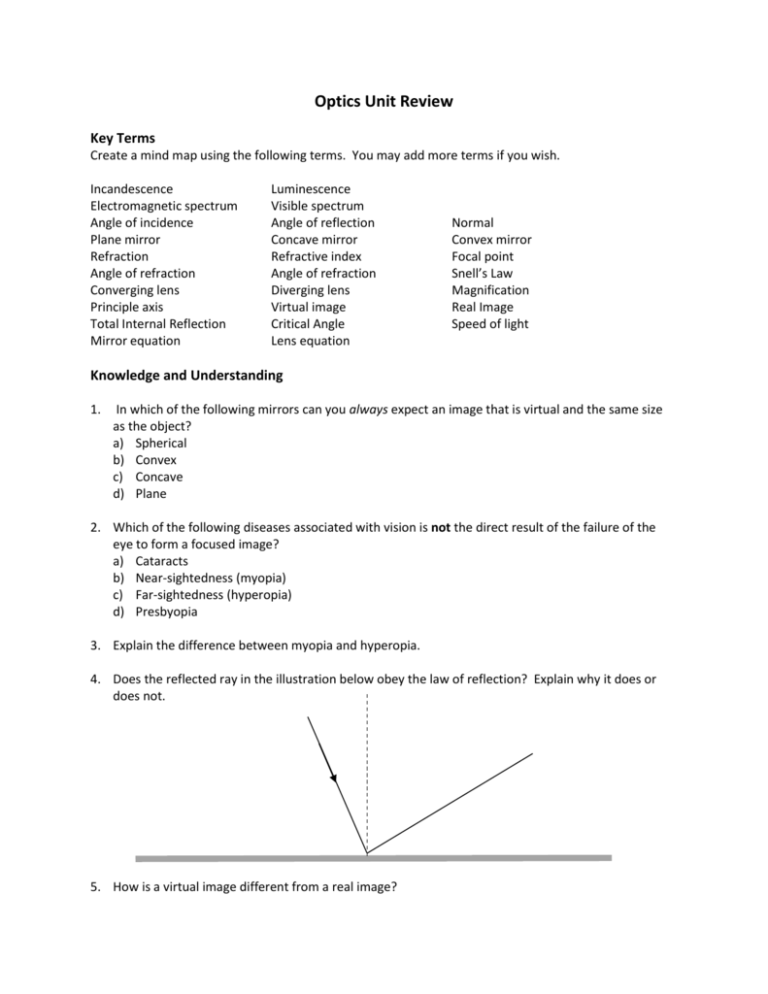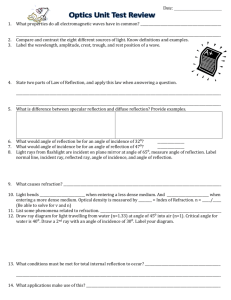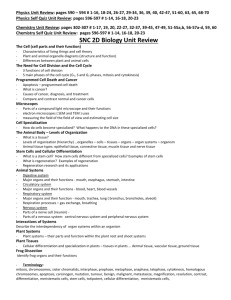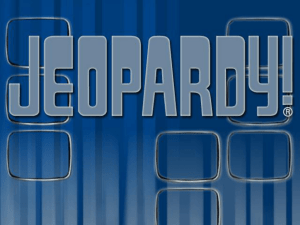Optics Unit Review Key Terms Create a mind map using the
advertisement

Optics Unit Review Key Terms Create a mind map using the following terms. You may add more terms if you wish. Incandescence Electromagnetic spectrum Angle of incidence Plane mirror Refraction Angle of refraction Converging lens Principle axis Total Internal Reflection Mirror equation Luminescence Visible spectrum Angle of reflection Concave mirror Refractive index Angle of refraction Diverging lens Virtual image Critical Angle Lens equation Normal Convex mirror Focal point Snell’s Law Magnification Real Image Speed of light Knowledge and Understanding 1. In which of the following mirrors can you always expect an image that is virtual and the same size as the object? a) Spherical b) Convex c) Concave d) Plane 2. Which of the following diseases associated with vision is not the direct result of the failure of the eye to form a focused image? a) Cataracts b) Near-sightedness (myopia) c) Far-sightedness (hyperopia) d) Presbyopia 3. Explain the difference between myopia and hyperopia. 4. Does the reflected ray in the illustration below obey the law of reflection? Explain why it does or does not. 5. How is a virtual image different from a real image? 6. Copy the following concept map shown here and fill in the boxes: Diagram for the law of reflection Mathematical equation for the law lawsof of reflection reflection State the law of the reflection Explanation of the labels in the diagram Explanation of the meaning of the laws of reflection 7. a) Name five different sources of light. b) Give an example of each source. c) The colour white is often associated with purity and this colour was once considered the only “pure” form of light with other colours (red, green, blue etc) occurring as “stained” white light. Explain why this concept of white light was wrong. 8. State two practical uses for: a) A concave mirror. b) A convex mirror. 9. a) Draw a ray diagram of an object 0.75 F from a concave mirror. b) Draw a ray diagram of an object 0.75 F from a convex mirror. 10. What is the definition of refraction? 11. a) What is the definition and formula for the index of refraction? b) How is the index of refraction related to the speed of light in a substance? 12. a) Define critical angle. b) How can the value of the critical angle be calculated? 13. a) Draw a ray diagram for an object 0.75 F from a converging lens. b ) Draw a ray diagram for an object 1.25 F from a converging lens. 14. List the two parts of the eye that can refract light. 15. What structure controls the amount of light that enters the eye? 16. What is cause of: a) Far-sightedness (hyperopia) b) Near-sightedness (myopia) 17. a) What type of vision problem does the eye below have? b ) Copy the diagram into your notebook. Add a correcting lens to your diagram and show how the lens bends the light rays to focus the image on the retina. Skill Practice 18. A movie projector magnifies an image on 70.0 mm film to fill a screen 2.40 x 104 mm wide screen. What is the magnification provided by the projector? 19. A 20 cm long pinhole camera is used to photograph the CN tower. If the actual CN tower is 553 m tall and the image is only 4.7 cm tall, how far away was the photographer from the tower? 20. A concave lens produces a virtual image of a flower petal 2.00 cm from the lens. Determine the magnification of the lens if the actual petal is located 8.30 cm in front of the lens. 21. Draw a ray diagram to show how a plane mirror produces an image of the object shown below. 22. Light travels through a salt crystal that has a refractive index of 1.52. What is the speed of light in the crystal? 23. a) In a sapphire travels at 1.71 x 108 m/s. What is the refractive index of this gemstone? b) Draw a ray diagram to show how light will bend when passing through a sapphire. c) Calculate the critical angle for light going from sapphire back into air? 24. Titan is a moon of Saturn that has liquid methane in the atmosphere. Liquid methane has an index of refraction of 1.29. If a beam of light from the Sun approaches the atmosphere of Titan at an angle of incidence of 36.0°, what is its angle of refraction after the beam has entered the methane? Recall that the index of refraction in a vacuum such as outer space is 1.00. 25. A human hair follicle appears to be 5.5 x 10-3 m in width when viewed by a lens that magnifies 50 times. What is the actual width of the hair follicle? 26. A converging (convex) lens produces a larger, upright, virtual image that is 12.25 cm in front of the lens. The object is located 5.10 cm away. What is the focal length of the lens? 27. A far-sighted person wearing a pair of glasses looks at the soup display in the grocery store. If the convex lenses in the glasses have a focal length of 2.40 m and forms a virtual image 2.60 m from the lenses, how far away is the soup display? Thinking and Investigation 28. The image of an object in a concave mirror is farther from the mirror than the object, larger than the object, real, and inverted. Draw a ray diagram that fits these criteria. 29. How can you experimentally determine the difference between the focal lengths of a shiny metal soupspoon and a shiny metal teaspoon? Explain your answer. 30. What will be the image position and magnification from a convex mirror with focal length = -10 cm when an object is located at 90 cm from the mirror? 31. Explain why the image formed in a pinhole camera is inverted and smaller than the object being photographed. Include a ray diagram. 32. While walking on a beach, you find a clear, colourless rock that may be quartz (n = 1.46) or a piece of glass (n = 1.52). Explain how you could use variations in the angles of refracted light and the index of refraction to determine whether the rock is glass or quartz. 33. Explain why you agree or disagree with the following statements. For any you disagree with, provide the correct statement. a) The normal is always drawn at 90° angle to the mirror or lens. b) When light is reflected from a curved mirror, the angle of incidence is twice the angle of reflection. c) Concave (diverging) lenses always produce virtual images while convex (converging) lenses always produce real images. d) A magnification of +2 means the object is upright and double the height of the object. 34. Many grocery stores carry “reading glasses” that you can buy to help you read small print. What type of lenses do you think these glasses use? Explain. Communication 35. Telescopes often contain very large mirrors. What type of mirror (plane, concave or convex) would your expect to find in a telescope? Explain your response. 36. Draw a ray diagram and write a short explanation to show why it is sometimes difficult to reach a coin that is underwater in a pond. 37. Society has benefited from the development of a range of optical devices and technologies. Use a graphic organizer describe he optical defines that are used in scientific research, transportation, security, entertainment, communication and medicine. 38. Explain how a fiber optic cable can transmit information using light. 39. Using ray diagrams, describe the differences between refraction and reflection as a way to change the direction of a light ray. State any law or laws that describe each effect. Application 40. How have various optical technologies changed human perceptions of the natural world? 41. Describe how different types of mirrors can be used in the following circumstances: a) Dental office d) Bathroom. b) Variety store e) Solar oven c) Winding roads through a mountainous region 42. Sketch a colour ray diagram that shows how each of the different colours of the visible spectrum (light spectrum) are refracted to explain how dispersion in a glass prism works. Recall nair = 1.00; nred = 1.51; nviolet = 1.53. 43. Examine the diagram below and fill in the blanks: Diamond has a very high __________________________ (n = 2.42) compared to regular glass (n = 1.50). This means that light will travel ______________ in diamond than glass. As light goes from air into diamond (or diamond into air), it will be bent or _______________ more than in glass. When a light ray enters glass, it is bent _____________ the normal (see diagram). After passing through the glass, the ray is bent ___________ from the normal when it passes back to air. The critical angle for glass is 42o. This means that if the angle of incidence is _________ than 42o, all light will be reflected back into the glass. In glass, the ray of light will eventually pass out of the glass before it goes back to the eye of the observer. GLASS DIAMOND In diamond, the critical angle is only 24o. This means that a light ray that enters the diamond from above will only exit the diamond if the angle of incidence is __________ than 24o. Instead, the light ______________ back inside the diamond (angle of incidence _____________ the angle of reflection) until exiting the diamond on the same side it entered. This reflection inside the diamond is called ____________________________ and is the cause of the sparkle in diamond! Answers: 1. d) 2. a) 5. Angle of incidence Angle of reflection 5. A real image forms on a screen. 14. Cornea, lens 15. Iris 16. a) The eye is too short. b) The eye is too long. 17 a) myopia b) wear a diverging (concave) corrective lens. 18. 343 x 19.2.35 km (2350 m) 8 o o o 20. 0.241 x 22. 1.97 x 10 m/s 23. a) 1.75 b)17 ; TIR; 37 c) 34.8 24. 27.1o -4 25. 1.1 x 10 m (0.00011 m) 26. 3.6 cm 27. 31.2 m 28. Object must be between F’ and 2F’ 29. Locate object position where no image is produced; this is the focal point (F). 30 a) -9 cm; M=+0.1 x 33. Agree; disagree; disagree; agree 34.convex; create a magnified virtual image if do < F 35. Concave; they collect and focus light 41. a) concave (larger virtual image) b) convex (smaller virtual image of a large area) c) convex d) plane (same size as object) e) concave 43. refractive idex; slower; refracted/bent; towards; away; more; less; reflects; equals; total internal reflection. Good luck on the test and have a great Thanksgiving weekend!








